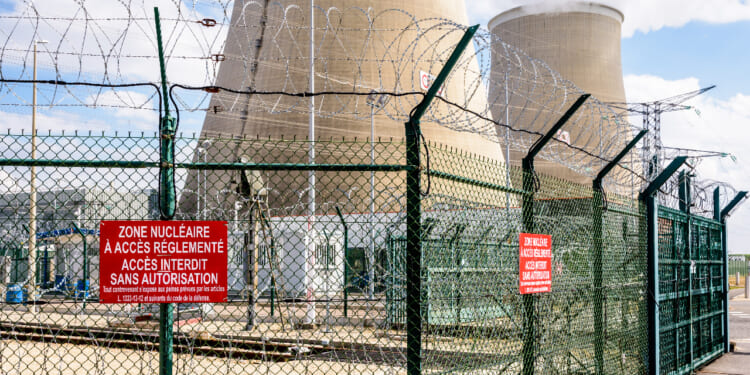Transatlantic nuclear relations between the United States and the European Union provide further avenues for expanding ties between the two power blocs.
Note: This article is part of the Center’s symposium on nuclear energy. To read other articles in the symposium, go here.
Energy has always been the foundation of human progress, driving productivity, health, and prosperity. Meeting the challenges of this century requires abundant, clean, and accessible energy.
By its capacity to simultaneously address environmental, economic, and social concerns, nuclear energy contributes to the sustainable growth of any economy.
The nuclear sector is poised for a transformative phase, resulting from the current geopolitical context, with key developments set to reshape the global energy landscape.
Indeed, this context has highlighted even more the need for countries to secure, as much as possible, their supply of energy sources, as energy is being used by some exporting nations to increase their influence throughout the world, a strategy termed “energy weaponization.”
The invasion of Ukraine has triggered a rapid geopoliticization of nuclear energy. Western governments have launched initiatives to support their national industries and compete with Russia in the global nuclear technology market. Simultaneously, efforts have intensified to reduce dependence on Russian-controlled fuel supply chains amid concerns that Moscow could leverage these interdependencies for geopolitical influence. Meanwhile, as Western policymakers focused on Russia, China unveiled an unprecedented acceleration of its nuclear energy expansion. As governments and industries compete to secure energy resources for AI-driven infrastructure, the availability of nuclear power is becoming a strategic concern, adding another layer of complexity.
In this context, how could France and the United States, which rely on nuclear as part of their energy mix, shape their ties to better address the resulting challenges?
Driven by energy security and environmental concerns, France, which derives 70 percent of its electricity from nuclear power, is the world’s second largest producer of nuclear electricity, just behind the United States, and the second among European countries in terms of clean power production. Its electricity cost is lower than that of various major European countries (i.e., Germany, Poland, and Spain), further strengthening its economic competitiveness. As a result, France is the world’s largest net exporter of electricity, with €3 billion in yearly revenue. 17 percent of France’s electricity is from recycled spent nuclear fuel.
France is gearing up to prepare its future nuclear program for the transition away from fossils. In 2022, it decided to ramp up its fleet by ordering the construction of six EPR2 reactors and laying options for eight more. Its fuel cycle facilities are being extended/refurbished. In 2024, construction started on the Georges Besse 2 enrichment plant, with the aim of increasing its production capacities by 30 percent. The La Hague reprocessing plant has been expanded and its lifespan has been extended until at least 2100. In 2023, the “France 2030” program was launched to respond to the challenges of our time, in particular the green transition, through a €30 billion investment plan in sectors of excellence, such as energy, for the emergence of SMRs.
As for the United States, it is the world’s largest producer of nuclear power, accounting for 30 percent of worldwide nuclear electricity generation. President Trump, last May, announced four executive orders aimed at reinvigorating America’s nuclear energy industry through the goal of quadrupling the United States’ nuclear capacity (to 400 GWe) by 2050. The orders lay out a plan to modernize nuclear regulation, streamline nuclear reactor testing, deploy nuclear reactors for national security, and reinvigorate the nuclear industrial base. They represent a bold new strategy for unleashing American energy and contributing to America’s dominance as the world’s nuclear energy leader.
As major players in the nuclear field, France and the United States already cooperate extensively bilaterally, in the regulatory, research & development and industrial sectors.
At a multilateral level, both are part of the 31 countries that pledged, on the sidelines of the COP28 summit in 2023, to globally triple nuclear energy capacity by 2050 in support of support climate goals. On the fuel cycle, they belong to the Sapporo 5 initiative, where five like-minded countries plan to expand their existing fuel cycle capabilities to ensure a nuclear fuel supply free from Russian influence and potential political leverage by other countries.
Today’s new context paves the way for further broadening of their bilateral ties in both countries’ interests, domestically and abroad.
In the R&D and regulatory sectors, similar technological choices made by both countries, namely fourth generation fast neutron reactors, offer grounds for joint research projects. France, through its Phénix and Superphénix projects, has extensive experience in that technology. The United States has started construction of such reactors, such as for TerraPower’s Natrium project.
In the industrial sector, both countries could potentially carry out domestic fleet expansion plans using each other’s supply chains when required. France’s Arabelle steam turbine is the most powerful turbine in operation and is suitable for all reactor types. The nuclear company Framatome is planning to expand its forging capabilities. This mutual assistance could also reach third markets, thus strengthening both countries’ competitiveness in terms of export markets in the face of international competition.
Regarding more specifically the fuel cycle, both the front end and back end offer strong potential for strategic collaboration, that would greatly contribute to President’s Trump energy dominance agenda.
Indeed, on the front end, French industry, with its decade-long experience in uranium enrichment, could help the DOE carry out its plans to set up domestic facilities that would help America wean itself off its dependency on foreign imports, especially from Russia, in addition to helping the United States become an exporting nation.
On the backend, President’s Trump’s decision to promote spent nuclear fuel recycling and reprocessing could potentially allow for stronger ties with French industry, which has used such technology for decades. As for high-level waste, France’s experience in the construction project of a deep geological repository could serve the US.
At a time when global energy politics are entering a more fractious phase, the need for collaboration has never been greater. The prospects for Franco-United States cooperation are numerous, which would benefit each country’s domestic nuclear energy program, as well as contribute to the sustainability of nuclear energy, all while helping the United States, along with its allies, regain their competitive global position in a world where, today, the dominant global supplier is Russia and the fast-rising rival is China.
About the Author: Sunil Félix
Dr. Sunil Félix has been the Nuclear Counselor at the French Embassy in Washington, DC since 2020, having previously served in the same position at the French Embassies in South Korea, India, and Japan. Following a PhD and post-doctoral studies in Mathematics, he joined the French Alternative Energies and Atomic Energy Commission (CEA – France) in 1990. Since then, he has been working as a research engineer in the Structural Analysis field. He was also the Personal Assistant to the Chairman of the Generation IV International Forum (GIF), from 2006 to 2010 during the French Presidency of the Forum.
Image: Shutterstock/olrat

















